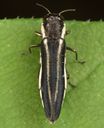Metallic Wood-boring Beetles
Buprestidae
Classification
- Phylum: Arthropoda
- Subphylum: Hexapoda
- Class: Insecta
- Order: Coleoptera
- Suborder: Polyphaga
- Superfamily: Buprestoidea
- Family: Buprestidae
Pronunciation
How to pronounce Buprestidae: /bjuˈprɛstɪdiː/
These audio files are automatically generated. While they are not always 100% accurate, they are a good starting point.
Images






Summary
Buprestidae, known as jewel beetles or metallic wood-boring beetles, are a diverse family of beetles characterized by their glossy iridescent colors and the unique life stages of their larvae, known as flatheaded borers. While they generally inhabit dying wood, some species can infest healthy plants, leading to economic damage, while also playing essential roles in ecosystem processes.
Physical Characteristics
Shape is generally cylindrical or elongate to ovoid, with lengths ranging from 3 to 80 mm (0.12 to 3.15 in), although most species are under 20 mm (0.79 in). A variety of bright colors are known, often in complicated patterns. Their iridescence is due to structural coloration, caused by microscopic texture in their cuticle that reflects specific frequencies of light.
Identification Tips
Look for glossy iridescent colors on their elytra. A characteristic of their mines is they are packed tightly with layers of sawdust-like borings and pellets; the walls are scarred with fine, transverse lines.
Habitat
Generally found in dying or dead branches of trees, but some species also inhabit roots, logs, stems, and leaves of various types of plants including herbaceous and woody plants, as well as recently burned forests.
Distribution
Widespread, with nearly 760 species in North America and about 15,000 species worldwide.
Diet
Larvae bore through roots, logs, stems, and leaves of various types of plants, usually preferring dying or dead branches on otherwise healthy trees.
Life Cycle
Usually 1-2 years but can take many years in certain species, with life cycles similar to those of roundheaded borers.
Reproduction
Lay eggs in dying or dead wood, with the preference for recently burned forests noted for some species.
Ecosystem Role
As wood-boring insects, they play a role in breaking down dead and dying trees, contributing to nutrient cycling in forest ecosystems.
Economic Impact
Some species can be serious pests, capable of killing trees and causing major economic damage. For example, the invasive emerald ash borer has significant impacts on ash tree populations.
Cultural Significance
The larger and more spectacularly colored species are prized by collectors and have been traditionally used in beetlewing jewellery and decoration in some Asian cultures.
Collecting Methods
- Manual collection from suitable habitats
- Light trapping
Preservation Methods
- Pinning
- Ethanol storage
Evolution
Classification is still being refined, with some systems defining up to 14 subfamilies, suggesting a complex evolutionary history.
Similar Taxa
Misconceptions
The iridescent colors are often thought to be due to pigments, when in fact they result from structural coloration.
Tags
- beetles
- Buprestidae
- entomology
- insects
- ecology
- collecting